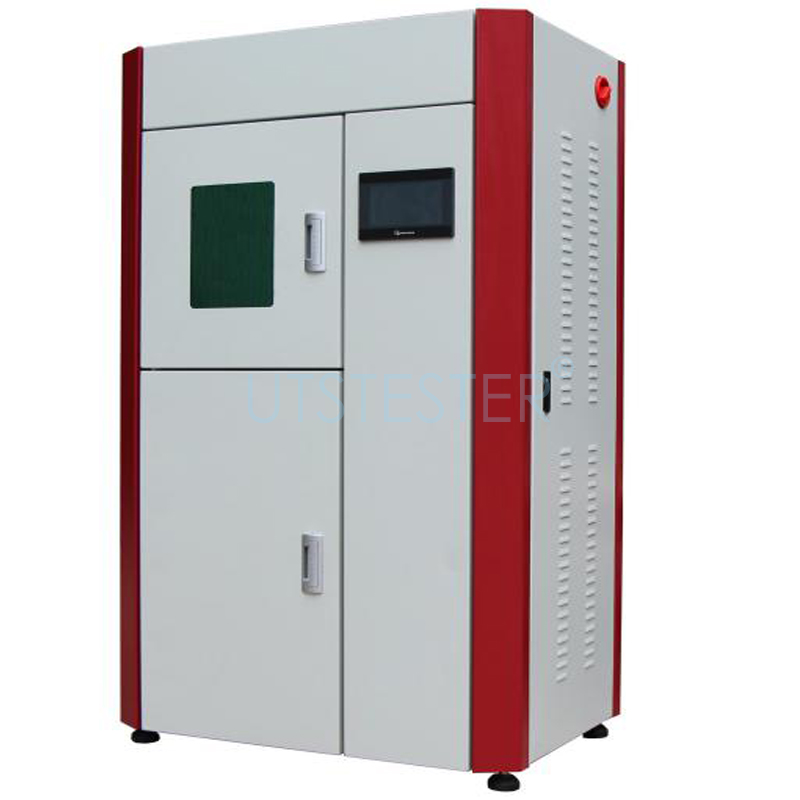 +86 152 6060 5085
+86 152 6060 5085
 +86 152 6060 5085
+86 152 6060 5085
2019-03-21
The fastness tester is mainly used to test the aging properties of automotive materials, plastics, inks, paints, coatings, packaging, photochemical materials, pigments, dyes, stabilizers, additives, industrial and surface textiles.
Applicable standards:
AATCC tm16-1998, AATCC tm16-2004, AATCC TM169, ASTM C1442
Main parameters:
1. Light source: 6500W water-cooled xenon lamp;
2. Service life (1 solar standard) : 1200 hours;
3. Filter: the internal and external filter can be replaced;
4. Irradiance control: 340/420 or 300-400nm select single point automatic control, and choose the second point monitoring;
5. Light monitoring: SmartLightTM monitor;
6. Relative humidity control: automatic;
7. Humidity range: light cycle :10-75%(determined by temperature), dark cycle: up to 100%;
8. Temperature control: automatic.
Insolation fastness testing machine adopts simulated natural environment to test the fading degree of textiles under sunlight irradiation. Especially for colored substances, it can produce the same heating effect as sunlight, which greatly improves the accuracy and reproducibility of test results.The influence of dye concentration, moisture content, pH value and fastness promoter on the fastness to the sun of the fabric was compared and analyzed.

Factors affecting the color fastness of textiles to sunlight:
Effect of dye concentration on color fastness to sunlight: the color fastness of cotton fabric is related to the variety of dyes. The lower the dye concentration, the worse the color fastness.
The influence of pH value on the color fastness of cotton fabric: pH value has a great influence on the color fastness of cotton fabric to the sun. The best color fastness of cotton fabric to the sun is in the vicinity of neutral, while neither acid nor alkaline cotton fabric has a good color fastness to the sun.
Effect of moisture content on color fastness to sunlight: moisture content has a great influence on the color fastness to sunlight of cotton fabric.This is mainly because the greater the moisture content of cotton fabric, the larger the area of the dye particles on the surface of the fabric and the effect of moisture, the color fastness will be reduced.
Effects of sun fastness promoters on sun fastness: sun fastness promoters are effective in improving the sun fastness of cotton fabrics and must be used in conjunction with other finishing processes.
In addition, when textile manufacturers invest in testing laboratories, one of their investments is a fastness tester.Therefore, the selected instrument must be able to meet current and future test requirements.The textile industry's two most important standards for color fastness to the sun, one is the most European retailers reference to the ISO standards;The other is the AATCC standard used by us retailers.
Textile manufacturers need to assess not only their existing customers and their needs, but also their future customers' needs.Because not all color fastness testers have the same function or meet all the standards required by retailers, it is critical to understand current and future customer needs.
The AATCC16 test method for color fastness to sunlight is a traditional test method that has become increasingly complex over time and the number of items available has increased.One of the most important changes was the addition of a xenon light source (option E), especially a water-cooled xenon lamp.The E option in test method 16 also details other features of the test.
The textile industry chose 16E for all levels of testing.Retailers have added this option to their test specifications, so their suppliers must comply.In 2003, the AATCC16 test method was modified again, this time by opening some parameters.This change makes it possible to use a wide range of color fastness testers, rather than just a few as before.
Unlike traditional testing methods, this change enumerates the number of options rather than describing them verbatim.The modified more extensive xenon lamp option is currently option 3, however test method 16E has not been abandoned.Many retailers still use this method in their own testing because they don't want their historical data to change too much, since 16E has been used since 1964.Different color fastness tester may produce different test results.
Iso105-b02 artificial light fastness to sunlight: the xenon arc fading light test is a widely used international standard for fastness to sunlight.However, like many other ISO standards, it initially reflected European practice and was later modified to include air - and water-cooled xenon arc lamps.As a test option, it includes both test conditions commonly used in Europe and those commonly used in the United States.The testing conditions in the United States are actually a reiteration of AATCC16E.
Email: hello@utstesters.com
Web: www.utstesters.com
Tel: +86 596 7686689
Direct line: +86 15260605085
Previous article :
Test method for moisture resistance of rustproof paperNext article :
Fabric tensile strength test